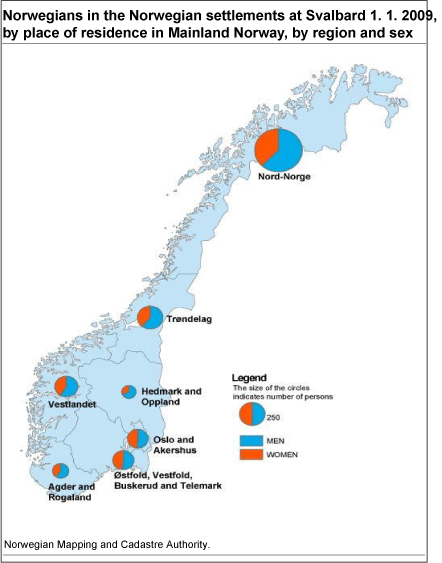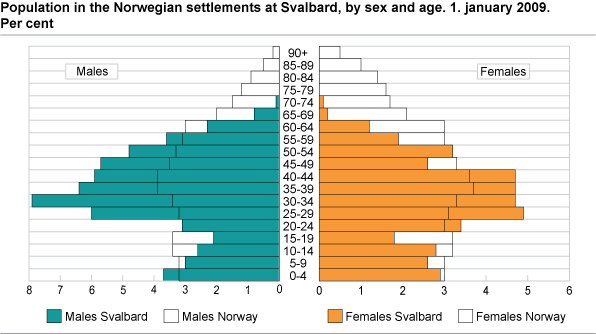Content
Published:
This is an archived release.
2 085 in Svalbard’s Norwegian settlements
A total of 2 085 persons were registered in the Norwegian settlements at Svalbard as per 1 January 2009; 1 212 men and 873 women. Including the population in the foreign settlements, the population of Svalbard was around 2 570.
Longyearbyen, with over 2 000 inhabitants, is the most important settlement. Ny-Ålesund, the world’s northernmost permanent settlement, has a permanent population of about 25 persons. Svea, which is 60 km south east of Longyearbyen, has no permanent settlement, but many of the 385 employees in the mining company commute weekly or fortnightly to Longyearbyen, while the rest commute to the mainland. In addition to the residents, there are also a large number of people at Svalbard staying for short periods. People staying at Svalbard for less than six months are not registered as residents and are not therefore included in the statistics.
Besides the Norwegian settlements, there are about 470 persons in the Russian settlement Barentsburg. Hornsund, in the southern part of Spitsbergen, has a Polish research station, with a staff of 10. There are no statistics for these two settlements beyond the number of residents.
Who are counted as residents at Svalbard:The Population register of Svalbard (BRSV) comprises all persons living in the Norwegian settlements at Svalbard, who intend to stay for at least six months. This includes residents of Norway and foreign nationals living at Svalbard. Norwegian residents living at Svalbard are registered in two registers; as residents in a municipality in mainland Norway, and as a resident at Svalbard. |
Most people stay for a short time
Only 10 persons living in the Norwegian settlements at Svalbard today have been there since the 1960s, and 55 arrived in the 70s. More than half of the residents arrived after 2004. The average period of residence for those living in the Norwegian settlements today is six years.
There are 140 persons in the Norwegian settlements that have never lived outside Svalbard. More than 60 per cent of which are below school age, 90 per cent are under 18, while the oldest are about 30 years old.
Svalbard is an international community
The Norwegian settlements have residents from 36 different countries. A total of 293 of the inhabitants, 14 per cent, have come directly to Svalbard without living in mainland Norway first. Including the 470 persons in Barentsburg and 10 in Holmsund, the share of foreign nationals at Svalbard is 30 per cent.
Almost a third of the foreign nationals in the Norwegian settlements are from Thailand, 70 per cent of which are women. Almost a quarter of the foreign nationals are from other Nordic countries. All in all there are more men than women in the Norwegian settlement at Svalbard, but among the foreign nationals there are more women than men.
Few old ones, many men and quite a few children
There are not many people living at Svalbard. Compared to mainland Norway, Svalbard has a huge surplus of men aged 25-59 and women aged 25-44.
In Longyearbyen, there are 168 children under school age and 215 children between 6 and 15 years. There are few teenagers in the Norwegian settlements.
Births, deaths and migrations
Normally there are no children born at Svalbard. The women head for the mainland when the time of birth approaches. Nevertheless, the births are registered at Svalbard in the statistics if the mother is a Svalbard resident.
In the fourth quarter of 2008, six births were registered for women living at Svalbard. There were no deaths. According to the register, 44 persons moved to Svalbard and 70 moved away, which gives a net out migration of 26. Net out migration in the fourth quarter may be explained by seasonal variations in tourism, which peaks in February/March to September/October.
Tables:
Contact
-
Even Høydahl
E-mail: even.hoydahl@ssb.no
tel.: (+47) 95 77 79 06
-
Vilni Verner Holst Bloch
E-mail: vilni.verner.holst.bloch@ssb.no
tel.: (+47) 94 82 25 32
-
Dana Moe
E-mail: dana.moe@ssb.no
tel.: (+47) 99 85 23 42
-
Statistics Norway's Information Centre
E-mail: informasjon@ssb.no
tel.: (+47) 21 09 46 42


